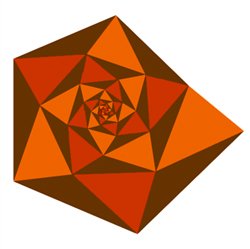
YE QiLan, Stellar Bloom, 1998 Most spirals, generated by students in past years in the Formative Design Studio, have been compound, geometric spirals with rotational periods that are factors of 360° and with radiants that, serving to mark off the periods, accommodate mirror-reflective symmetry. One of the objectives of this designer was to generate a geometric (i.e., logarithmic or equiangular) spiral that precludes the potential for the application of mirror-reflective symmetry and that winds in a dominant direction, characterized as either clockwise or counterclockwise in regard to the dilatative point of origin-though it must be granted that all geometric spirals that are regularly partitioned display multiple spiral vectors, which run both clockwise and counterclockwise. There may be innumerable ways to construct such a spiral, but this is the way this designer has done it. The period of her spiral (67°) falls between that of a regular hexagon (60°) and of a regular pentagon (72°). She started with a conveniently sized, kite-shaped diamond, derived from the partitioning of a regular hexagon. Increasing and decreasing them by a factor of 1.1, she then fanned an unending inward and outward continuum of diamonds at 67° intervals. Looking something like petals of a pine cone, these dilatating diamonds overlap. It is to be noted that the points of the diamonds nearest to the center of dilatation and the points farthest from it, as well as those between, all move commensurately in respect to the origin of dilation by a factor of 1.1, as they conform to a logarithmic sequence of similarities. The designer then singled out only the outermost points of the diamond petals; and connecting those points, she drew a line that appears to be more pentagonal than hexagonal. Finally, the designer reticulated the area between the contours of the crinkled spiral by connecting each of the outer vertices to the two closest inner vertices-thus triangulating the whole interstitial area that lies between. |

